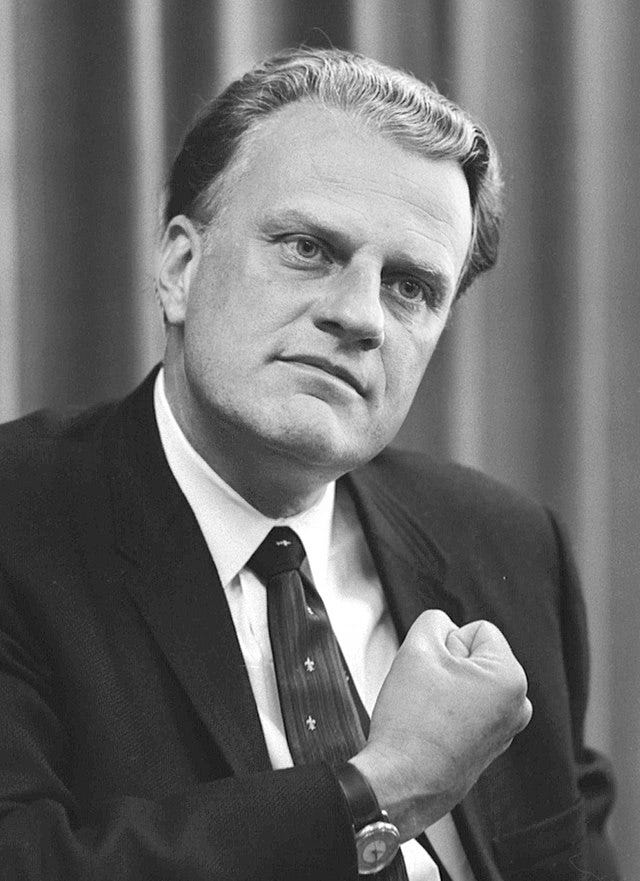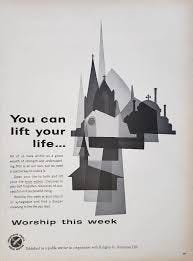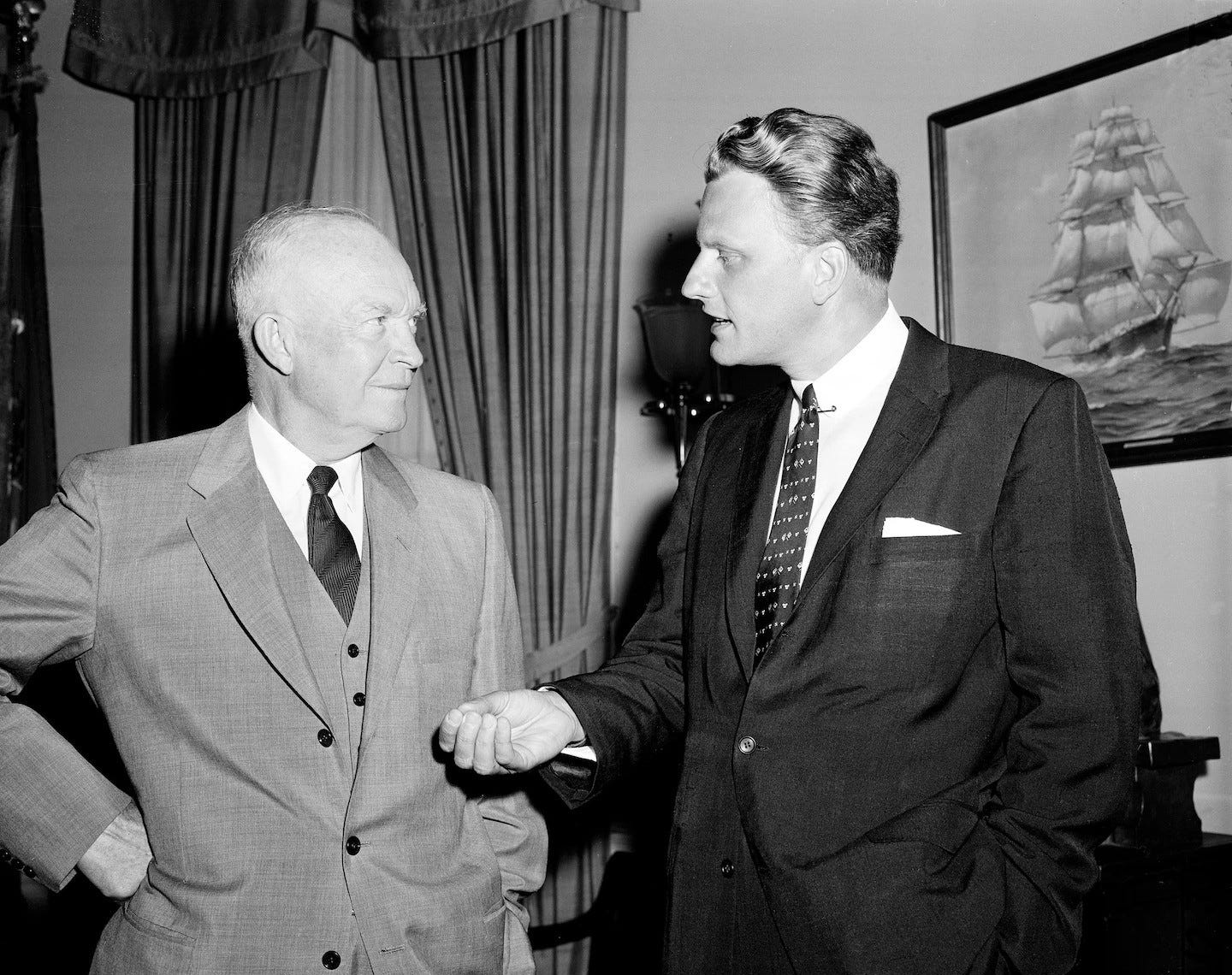How did corporate America find Jesus?
In my last post I began telling the story of Reverend James Fifield and a massive, corporate backed propaganda campaign called Spiritual Mobilization, designed to get people into church so that ministers could preach about the wonders of our free market capitalist system to unsuspecting followers.

In the wake of Rev. Fifield’s good works another contender emerged. A strong Southern Baptist, he has been called one of the most influential Christian leaders of the 20th century. With movie star good looks and clear passion for Christ, Billy Graham’s revivals packed stadiums like Lady Gaga. He broadcast his evangelical message on radio and television, a true Christian superstar. Recognized for his contributions to battling racial inequality, Graham is less known as a soldier of God who was also ready to fight the Cold War. Nicknamed “the Big Business evangelist” by the London Daily Herald, Graham was as hostile to organized labor and socialism (in the form of government involvement in the economy) as he was to the devil himself. One of Graham’s biographers noted how when the minister talked fondly of the American way of life, “he has in mind the same combination of economic and political freedom that the National Association of Manufacturers (NAM), the United States Chamber of Commerce, and the Wall Street Journal do when they use the phrase.” Billy Graham was known for affectionately speaking about the “rugged individualism” that Christ brought to this world.
These deliberate conflations of faith, freedom, and free enterprise kicked into an even higher gear when top ad company J. Walter Thompson was paid millions to sell the “Religion in American Life” campaign. On the surface the advertisements seemed to simply encourage people to go to church. What could possibly be wrong with that? There were no explicit rejoinders about God loving the free enterprise system. But the same messages of Christian libertarianism were skillfully embedded within. The idea was to convince the public that religion was the cornerstone upon which American democracy was based. No one suspected for a moment that the reason big business was paying millions to get people into churches was so they could be brainwashed about the glories of capitalism rather of the glory of God. And the good soldiers of Christ behind the pulpit played their roles to perfection, mixing piety with patriotism, making love of God and love of country indistinguishable from one another.
J. Walter Thompson was on hand to help local communities practice their good works. In the same way that Subway’s corporate office might send its regional manager a packet with instructions on how to get the word out about an exciting new footlong Philly steak sub, smalltown leaders were sent detailed plans outlining the “Seven Steps to a Successful Local Religion in American Life Program.” Included were marching orders about which local organizations should be recruited, how to organize the central committee, and which specific type of citizens should be placed in leadership positions. They even told town fathers precisely what to say. The mayor, for example, was told to make a proclamation that included the words, “Faith in Divine power was stamped on this nation’s first money with the words, ‘In God We Trust.’ Our religious beliefs have steadfastly endured as the foundation of our way of life.” Sound familiar? Some things never go out of style.
Around this time, business leaders were wining and dining war hero General Dwight D. Eisenhower to run as the GOP candidate for president in 1952. Ike was no dummy and instantly recognized the potential that this religious revival held for his political fortunes. Eisenhower talked openly about the importance of his faith. It was during his presidency, during a conscious “Back-to-God” program spearheaded by the GOP (that Democrats supported almost unanimously) that the line “one nation, under God” was added to the Pledge of Allegiance. It was also during his administration that “In God We Trust” was made the national motto, replacing the unofficial motto “E pluribus unum” (From many, one) and added to American paper currency.
The brand of religious nationalism that was born during that period lives on, stronger than ever today. But it is important to realize that it was born of a very specific moment in time in our nation’s history. The Cold War was a huge part of that moment. Soviet communism was steadfastly atheistic. Part of the effort to differentiate communism from capitalism was emphasizing this to the public in order to make communism seem even scarier. Eisenhower is quoted as having told the Religious Herald during his presidential campaign, “What is our battle against Communism if it is not a fight between anti-God and a belief in the Almighty? … Communists … have to eliminate God from their system. When God comes, Communism has to go.” He wasn’t the only one using religion to make the godless communists seem terrifying to the American public. Australian Fred Schwartz, founder of the Christian Anti-Communism Crusade made an entire career out of precisely that. One ad for Schwartz, paid for by executives at the Allen-Bradley Company of Milwaukee blared “WILL YOU BE FREE TO CELEBRATE CHRISTMAS IN THE FUTURE?... NOT UNLESS: You and other free Americans begin to understand and appreciate the benefits provided by God under the American free enterprise system.” The commies are coming to steal Christmas?! If that happens, will the KGB kill Santa Claus?
Here’s the thing: These efforts by organizations like Spiritual Mobilization, fundamentalist preachers like Billy Graham, ad campaigns like “Religion in American Life,” political figures, especially Dwight D. Eisenhower, and anticommunist zealots like Fred Schwartz were wildly successful. They truly ushered in an unprecedented religious revival in the United States. Consider how the percentage of Americans who claimed membership in a church climbed during that time. Kevin Kruse writes that in 1850 just 16 percent of Americans claimed church membership. It was only 36 percent in 1900. Between 1910 and 1940 that number climbed to up 49 percent. During the period discussed here that number suddenly skyrocketed to 57 percent in 1950 and an all-time peak of 69 percent in 1960. The payoff from these efforts far surpassed anything that the sad bois at the 1940 NAM conference in New York could ever have imagined. Yet it was also temporary. In 2020 church membership fell back to an 80 year low of 47 percent.
It is essential to remember that these efforts had conscious intent. One of the byproducts of the success of this “freedom under God” movement is the mistaken impression that public religion has always existed in this country and is an important tradition that goes back to the nation’s founding. Not so. I will grant that there are references to a deity in the Mayflower Compact, the National Anthem, the Declaration of Independence and almost all state constitutions. There are frequent references to a deity in official oaths and proclamations. Days of Prayer have been called during times of national anxiety going all the way back to the Continental Congress. However, when you hear every modern American president end almost every speech with “God bless America,” that is different. That is what amounts to a political slogan and it is an invention of the modern era. As Kevin Kruse writes, today’s ruling class understand the political power of public displays of faith – as well as the price of its absence. He continues, writing “such touchstones of religious nationalism have only become more deeply lodged in American political culture over time, as the innovations of one generation become familiar traditions for the next… we have forgotten their origins. More than that, we have forgotten that they have origins at all.”
In my next post I'll take a deeper look at corporate America's deeply cynical religious fervor. Until then...
Please give a like, comment, restack, and share to help others find me here on Substack.
Let’s make them pay.


















Share this post